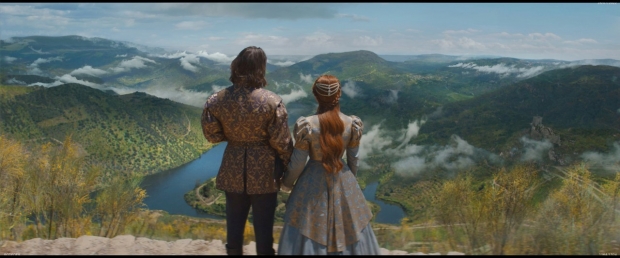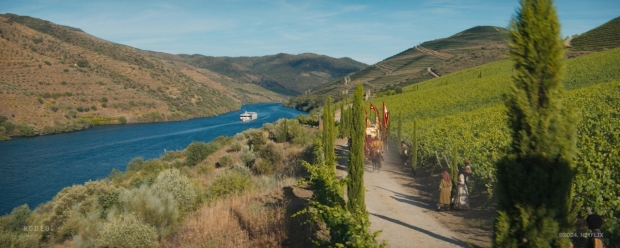Led by VFX supervisor Mathieu Dupuis, the studio’s visual effects work brings audiences back to medieval times, with a touch of faerie tale and fantasy elements, including unique castles, enchanting countryside, and the spikey Stone Mountain cave where the titular character, played by Millie Bobby Brown, meets a fire-breathing dragon.
As an actress, Millie Bobby Brown cannot avoid battling monsters, from the demons of the Upside Down in Stranger Things to a dragon that can speak and has an unquenchable appetite for snacking on princesses in the film Damsel. Principal photography on Damsel took place in England and Portugal, with filmmaker Juan Carlos Fresnadillo (28 Weeks Later) helming the fantasy adventure that included key contributions from Cinematographer Larry Fong (Kong: Skull Island) and Production Designer Patrick Tatopoulos (Justice League).
Now streaming on Netflix, the film tells the story of a dutiful damsel who agrees to marry a handsome prince, only to find the royal family has recruited her as a sacrifice to repay an ancient debt. Thrown into a cave with a fire-breathing dragon, she must rely on her wits and will to survive.
Central to the visual language of the film are the Land of Aurea, the Stone Mountain, and the cave system where the fire-breathing mythical creature lives, for which leading VFX house Rodeo FX combined Medieval Europe with fantasy elements under the direction of Visual Effects Supervisors Nigel Denton-Howes and Nicholas Brooks.
“Portugal is pretty but was not nice enough to make the Land of Aurea happen,” states Mathieu Dupuis, VFX Supervisor, Rodeo FX. “We’re in Medieval times, but with a faerie tale touch. There was something purely cinematographic about those images we were creating, meaning we had the reality of Portugal but also wanted to open up the world. Sometimes, it’s about creating a frame that has a better balance for the story that we need to tell.” The main landmarks were the castle and the Stone Mountain. “It’s a clever way to illustrate the metaphor that they’re rich and have this nice clean golden almost unreal looking castle, and that’s the façade,” notes Dupuis. “Behind them, they have this big creepy mountain that is always in the dark. The real center of the story is the mountain, inside of which is the dragon.” The visual link between the Stone Mountain and the dragon was important, he continues, “with those ridges and ledges of the Stone Mountain that were spikey. And if you look at the dragon, everything around her head is spikey as well. There is something that is rough and menacing that links the two of them together.”
Impacting the lushness of the Portuguese scenery was last year’s severe drought. “There was no rain for a long time, and everything was yellow and burnt out, so we were asked to make it look like what Portugal is normally like when it’s not that dry,” remarks Dupuis. “In the far distance we were keeping the vegetation as a digital matte painting as there was not much in the way of camera movement. But when it is closer to us and all those little flowers, bushes and CG crowds required a complex camera movement, then we flipped into environment mode.” The Convento de Cristo in Portugal was used for the base of the castle. “We had an architectural discussion with [Production Designer] Patrick Tatopoulos about how those castles were made,” Dupuis notes. “[In the film] They’re not built in 10 years. The second section is richer, and the top part is the richest because that’s when they made that deal with the dragon and have a lot of money. The bottom section is dirtier and has more stains, but the roof is golden. I looked at so many hours of castles!”
A set was built for the narrow land mass situated across a crevasse where the wedding ceremony takes place. “Patrick had this idea late in the game of having a 45-degree arch and the column standing on top of it,” states Dupuis. “We had to recreate that and blend it with the rest of the set. Every call they made for that movie was to help the result of the imagery. The challenging part, when we get inside, is everything regarding cliff and cave because we need to throw this lady inside this cave that has no light, but we still need to see. It’s always the same conundrum.” One particular creature provided some internal lighting. According to Dupuis, “We had reference from New Zealand for how the glow worms should look. It was surreal. We had to decide whether to go for the real thing, because glow worms are small, and onset they tried to build some stuff that was creating light that wasn’t sexy enough. We used the light that they created onset but recreated everything. We worked in Houdini, which was helpful because in an instant we were able to have a different shape for the glow worm. Once we matched the LiDAR of the set, we populated our glow worms here and there, and did a session with Nigel Denton-Howes about how long, small, and bright at the end they should be. Finding the right look went fast.”
In the movie, Elodie (Millie Bobby Brown) climbs up the side of a cave filled with crystal spikes. “We called it the ‘Rambo Sequence’!” laughs Dupuis. “She is cutting her hair and wrapping stuff on her hands and feet to climb up. That was a tricky scene. It’s not my first movie where we needed someone to climb up something. They did a good job with the set but it’s always a tiny section that gets repeated and we had to make it like she is getting higher and higher. We had to duplicate that set and it’s made of crystals which are translucent and refractive. Onset it was great, but the first thing they said to me was, ‘We need to feel the bling bling.’ So, we had to enhance the set. It was like reverse engineering, as we needed to create a CG extension that matched the set. We also need to see the path up that she was going to climb. Darkness is a compositor’s best friend and worst enemy sometimes because when you’re working in those low light levels, a slight difference of colors shows up right away. We also had to add falling dust, which catches the light.” Dupuis also notes that a virtual camera was sometimes used to take over from the live-action plate, as there was “no way that they could put an actress that high.”
At the top of the crystal cave is an opening within an enormous mountain that’s featured as the camera dramatically pulls back. “The first movement they asked us to do was a straight pullout; however, it was no impressive enough because you don’t feel the parallax and shape of the mountain,” Dupuis reveals. “It felt like a flat mountain. We proposed different camera movements and approaches so we can feel the height and know Elodie is somewhere inside of the mountain.”
Atmospherics like mist assist in conveying the environment’s proper size and scale. Noting their work on the Dragon Gate, Dupuis says, “We built a cool asset for the Dragon Gate that had so much detail. Then, we put it through the fog. There was so much fog, which is a CG effect because of the movement.” Achieving the proper obscurity and readability was hard. He adds, “You need to feel that they’re huge dragons. We used the Golden Gate Bridge in San Franscisco because sometimes they have this kind of weather and a boat is passing under and you don’t see the bridge and some point, boom! It’s appearing and is massive. You cannot make out what is what. Obviously, because we’re artists and people want to show their work, the first version we proposed to Nigel didn’t have much fog. He said, ‘That’s nice but we’re going to bury it in the fog.’ He was right because it helped with the size and scale. That was fun to work with.”





























